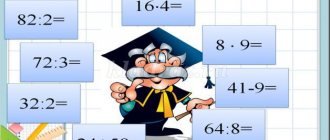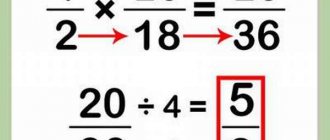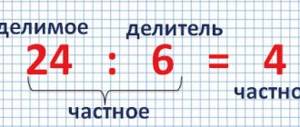Math cards for grade 3 “COMPOSITION PROBLEMS”
MBOU "Verkhnemedveditsa secondary school"
Kursk district, Kursk region
INDIVIDUAL CARDS
FOR 3rd CLASS ON THE TOPIC:
Primary school teacher
first qualification category
Alferova Galina Nikolaevna
__________________________________________________________________________________________
Card No. 1.
Full name
__________________________
Solve the problem:
There were 56 adults on the river bus, and 18 fewer children. How many people were on the water bus?
______________________________________________________________________________________________
Card No. 2.
Full name
__________________________
Solve the problem:
Vanya received 25 A's in the quarter, and 12 less B's. How many marks did Vanya receive in total?
______________________________________________________________________________________________
Card No. 3.
Full name
__________________________
Solve the problem:
The school workshop repaired 34 mops and 7 fewer brushes. How many mops and brushes have you repaired?
______________________________________________________________________________________________
__________________________________________________________________________________________
Card No. 4.
Full name
__________________________
Solve the problem:
There were 100 different instruments in the workshop. Of these, 41 are files, 20 are chisels, and the rest are chisels. How many chisels were there in the workshop?
______________________________________________________________________________________________
Card No. 5.
Full name
__________________________
Solve the problem:
There are 35 books on one shelf, and 26 more books on the other. How many books are there on two shelves?
______________________________________________________________________________________________
Card No. 6.
Full name
__________________________
Solve the problem:
We bought 30 rulers, and 9 less triangles. How many rulers and triangles did you buy?
______________________________________________________________________________________________
__________________________________________________________________________________________
Card No. 7.
Full name
__________________________
Solve the problem:
The music school has 45 violin students, and 23 fewer flute students. How many violinist and flutist students are there in the music school?
______________________________________________________________________________________________
Card No. 8.
Full name
__________________________
Solve the problem:
During the winter there were 32 sunny days, and in the spring there were 19 days more. How many sunny days were there in winter and spring?
Math problems for grade 3 with solutions and answers in 3 steps | Helping a schoolchild
Find the angles of a triangle if a) the interior angle not adjacent to it is equal to 40 degrees; b) the interior angles not adjacent to it are in the ratio 2:7; c) one of the interior angles not adjacent to it is larger. If the external angle of a triangle is 99, then the adjacent internal angle is 180-99 = 81 degrees.
Final test for the 2nd quarter in mathematics, grade 3. Test 3
The weight of 4 identical baskets of currants is 20 kg. Find a mass of 7 such baskets with currants.
The tourists were accommodated in 4 identical tents, 6 people each, and 3 identical houses, 10 people each. How many tourists were accommodated in tents and houses?
In one village there are 9 brick houses and 36 wooden ones. How many times more wooden houses than brick ones are there in this village?
On the store shelf there were the following toys: dogs, hares and bears. There were 6 bears, 3 hares. There were 2 times more dogs and hares than bears. How many dogs were on the shelf?
For 5 identical notebooks we paid 30 rubles. How many rubles should I pay for 6 such notebooks?
At the exhibition of drawings, 3 large stands had 8 drawings each, and 4 small stands had 5 drawings each. How many drawings were there in total on these stands?
In one day, the store sold 18 tracksuits and 6 jackets. How many times more tracksuits were sold than jackets?
The vase contained sweets, gingerbread cookies and waffles. There were 8 sweets, 5 gingerbreads. There were 3 times more waffles and gingerbreads than sweets. How many waffles were there in the vase?
Mom is 32 years old and son is 8 years old. How many times is the mother older than the son?
For 5 identical notebooks we paid 35 rubles. How much do 7 of these notebooks cost?
All the oranges were placed in 3 bags, 6 oranges each, and 4 bags, 5 oranges each. How many oranges were put into these bags?
There were textbooks, notebooks and pens on the table. There were 8 textbooks, 6 notebooks, and there were 3 times more textbooks and pens than notebooks. How many pens were on the table?
There are 18 jars of compote in 3 identical packages. How many cans of compote are in 7 such packages?
A set of felt-tip pens costs 54 rubles, and a notebook costs 9 rubles. How many times more expensive is a set of markers than a notepad?
For the New Year's holiday, we bought 3 boxes of cakes, 6 cakes in each, and 5 boxes, 4 cakes in each. How many cakes did you buy?
The vase contained apples, pears and bananas. There were 7 pears, 5 bananas, and 3 times more apples and pears than bananas. How many apples were there in the vase?
Math problems for 3rd grade
To prepare lunch, the cook needed 24 kg of potatoes, 3 times less beets, and 2 times less onions than beets. How many kilograms of onions did the cook spend?
Olya cut out 5 squares, 7 triangles, and 2 times more circles than triangles from paper. How many figures did Olya cut out?
The first number is 12, the second is 3 times less, and the third is 4 times more than the second. Calculate the sum of these three numbers.
- Solution:
1) 12 : 3 = 4 (second number) 2) 4 * 4 = 16 (third number) 3) 12 + 4 = 16 (sum of the first and second numbers) 4) 16 + 16 = 32 (sum of three numbers) Expression: 12: 3 * 4 + 4 + 12 = 32 Answer: 32
They brought 6 kg of lemons to the school canteen, 24 kg of apples more than lemons, and 12 kg of pears less than apples. How many kilograms of pears were brought to the school canteen?
- Solution:
1) 6 + 24 = 30 (apples were brought to the dining room) 2) 30 - 12 = 18 (pears were brought) Expression: (6 + 24) - 12 = 18 Answer: 18 kg of pears were brought to the dining room.
To prepare lunch, the cook needed 24 kg of potatoes, 3 times less beets, and 2 times less onions than beets. How many kilograms of onions did the cook spend?
- Solution:
1) 24: 3 = 8 (beets needed) 2) 8: 2 = 4 (onions needed) Expression: 24: 3: 2 = 4 Answer: The cook needed 4 kg of onions.
To prepare starch, 6 kg of potatoes are required. How much starch will be produced from 36 kg of potatoes?
24 boys went on the hike, and there were 3 times fewer girls than boys. How many children went on the hike?
A box of grapes and three identical boxes of apples weigh 45 kg. How much does one box of apples weigh if a box of grapes weighs 15 kg?
- Solution:
1) 45 - 15 = 30 (3 boxes of apples weigh) 2) 30 : 3 = 10 (one box of apples weighs) Expression: (45 - 10) : 3 = 10 Answer: 10 kg.
Children rode two and three wheeled bicycles in the playground. How many and what kind of bicycles were there on the site if there were 21 wheels and 8 bicycles in total?
- Solution:
1) 8 * 2 = 16 (there would be wheels if all bicycles were two-wheeled) 2) 21 - 16 = 5 2) 8 - 5 = 3 Answer: there were 5 tricycles and 3 two-wheelers on the site.
6 hazel trees were uprooted in the park, and 18 hazel trees were planted in their place. How many times more hazel trees were planted than were uprooted?
The father is 36 years old and the son is 9. How many times is the father older than the son and how many years is the son younger than the father?
- Solution:
1) 36 : 9 = 4 2) 36 - 9 = 27 Answer: the son is 4 times younger than the father; The father is 27 years older than his son.
The bus consumes 48 liters of fuel in 8 hours of operation. How many liters of fuel will the bus use in 6 hours of operation?
- Solution:
1) 48: 8 = 6 (the bus consumes liters of fuel in 1 hour) 2) 6 * 6 = 36 (the bus consumes liters in 6 hours) Expression: 48: 8 * 6 = 36 Answer: 36 liters.
Apricots were brought to the dining room. Of this, 3 kilograms were used for compote, and 3 times more for jam. How many apricots were brought to the dining room?
- Solution:
1) 3 * 3 = 9 (they took apricots for jam) 2) 3 + 9 = 12 (in total they brought apricots to the dining room) Expression: 3 * 3 + 3 = 9 Answer: 9 kg apricots.
Brief description of the conditions of the tasks in grades 1-4 of primary school
In order to visualize the problem and make it easier for yourself to solve it, a brief statement of the problem conditions is compiled. The brief record records quantities, numbers - data and sought, as well as some words showing what is being said in the problem: “was”, “put”, “became”, etc. and signs meaning relationships: “more” , “less”, “equal”, etc.
A brief recording of the task can be done in the form of a reference diagram, table, drawing, or using geometric shapes.
In order for a short note to contribute to the solution of the problem to the maximum extent, you need to:
1) Compile a short note based on an analysis of the text of the task; 2) The short entry must contain a minimum number of symbols; 3) The number of question marks in the short entry must correspond to the number of actions in the task;
4) Choose the form of the short note so that it more clearly represents the conditions of the problem.
Brief entry depending on the type of task:
Variations of the listed short notation options are possible depending on the conditions of the task. Recording in the form of tables and figures is also possible.
Examples of tasks:
– Vitya collected a collection of 18 stones and divided them equally into boxes. How many stones are in each jar?
A simple problem of dividing into equal parts, we arrange such problems in the form of a table
In 1 box Number of boxes Total stones? k. 3 k. 18 k.
– 8 invitations were placed in envelopes, 2 in each. How many envelopes did you use?
In 1 envelope Number of envelopes Total invitations 2 ave.? room 8 ave.
– Three friends decided to split their money equally and buy a ball worth 60 rubles. How much money should each of them give?
For 1 person money Number of people The total amount of money is shared equally by 3 people. 60 rub.
– A master should make one part in 45 minutes, but he does it in 38 minutes. How much time will a craftsman save when he makes 8 parts?
A compound problem for difference comparison is best presented in the form of a table.
– Vera planted 9 bulbs, 3 bulbs in a row. How many rows did you get?
This is a simple division task. It is more clear to represent such a task with a picture.
– Two cans of milk were brought to the kindergarten, 20 liters each. At breakfast the children drank 12 liters of milk. How many liters of milk are left?
The problem is to find the remainder.
Was - 20 l and 20 l Drank - 12 l
Left - ? l
– There were 24 m of fabric in a piece of fabric. Identical children's suits were sewn from 10 m of this fabric, and 7 identical children's coats were made from the rest of the fabric. How many meters of fabric were used for one coat?
Was -24 m Used - 10 m
Remaining – 7 k. for ? m
– When the brother watered 5 beds, and the sister watered 3 beds, they had 4 beds left to water. How many garden beds should children water?
Was - ? gr. Watered - 5 gr. and 3 gr.
Remaining - 4 grams.
– 33 rose bushes were brought to the park. When 6 bushes were planted in several flower beds, there were still 15 bushes left. How many flower beds were there?
It was - 33 k. They imprisoned - ? class 6 k.
Remaining – 15 k.
– 12 guys were playing hide and seek. They were joined by 3 girls and 4 boys. How many kids started playing hide and seek?
It was 12 p.m. They arrived - 3 days and 4 minutes.
It became - ? R.
– Sasha had 6 stickers. He gave his friend 2 stickers. Then Sasha bought 5 more stickers. How many stickers does Sasha have?
It was - 6 n. Gave - 2 n. Bought – 5 n.
It became - ? n.
– There were 14 cows grazing in the clearing, and 10 more sheep. How many animals were grazing in the clearing?
– On the first day they dug 5m trenches, on the second 3m less than on the first, on the third 1m more than on the second. How many more trenches were dug on the first and second days together than on the third?
– There were 17 kg of honey on two shelves. They sold 5 kg from the second shelf and there was an equal amount on 2 shelves. How many kg of honey were on 1 shelf?
It will be more clear to represent the task by writing it in the form of a diagram.
Explanations for solving problems
This form of working on a compound problem involves testing students’ ability to use given task-solving actions to explain what question the action answers and for what purpose.
Thus, at the end of each action we write an explanation of what exactly we found with this action.
This form of work helps students see other relationships, conduct the necessary chain of logical reasoning, analyze and draw conclusions.




